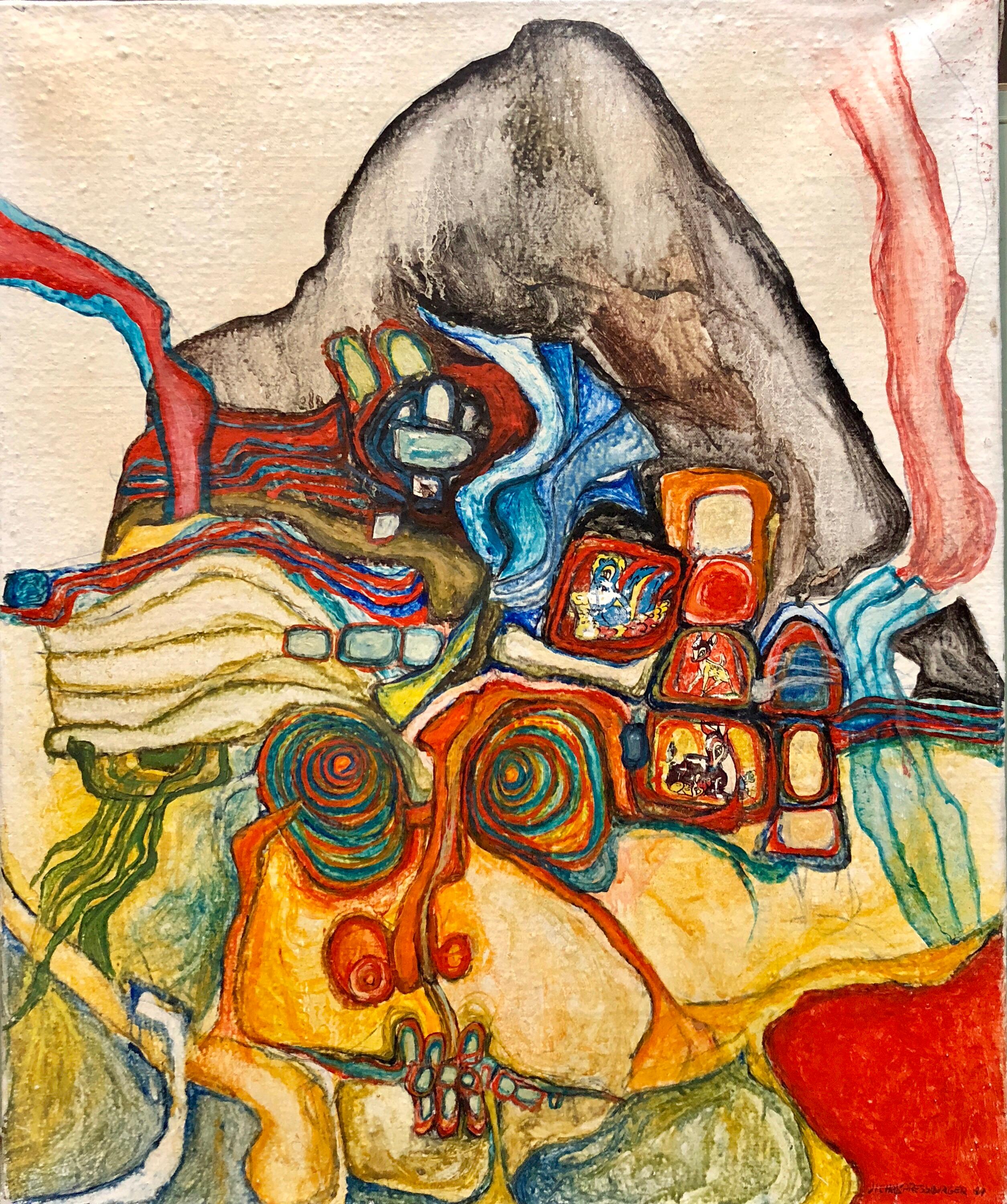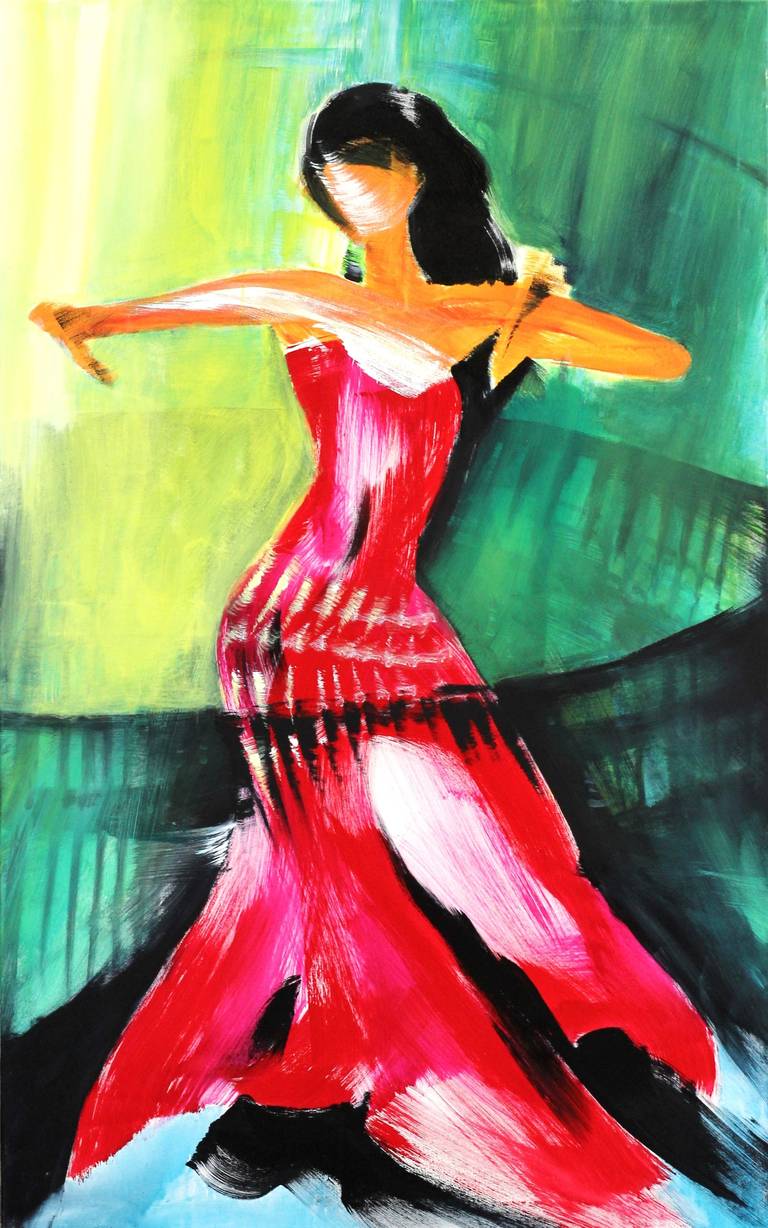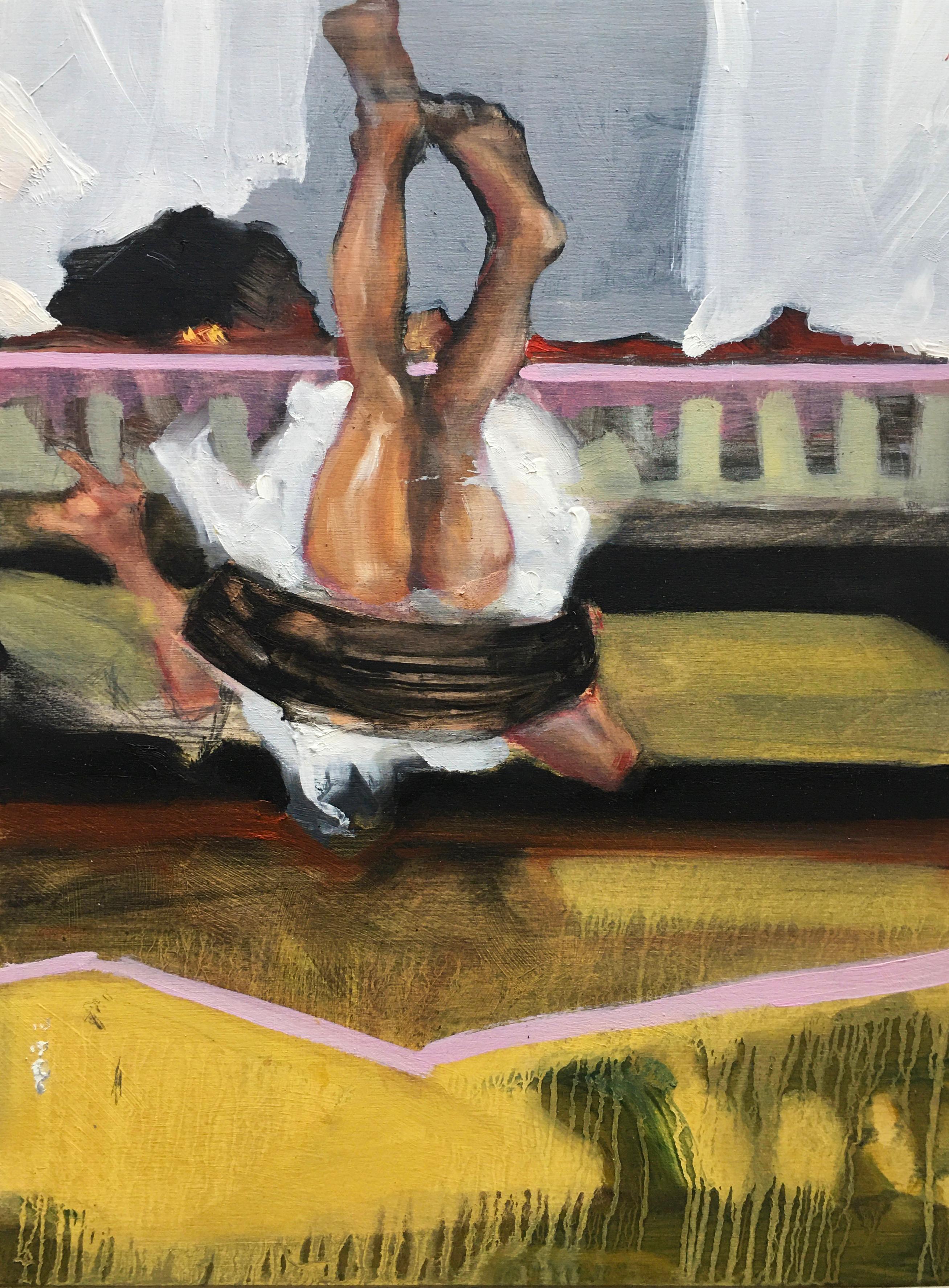Items Similar to Self Portrait
Want more images or videos?
Request additional images or videos from the seller
1 of 5
Jirayr Hamparzoom ZorthianSelf Portrait1953
1953
About the Item
Jirayr Zorthian(1911-2004), went through two Turkish massacres before age eight. He left Turkey at age nine with his family and spent a year in Padua, Italy, waiting for his visa to open to the United States. This period was very important in his life because his father took him to many cities in Europe and exposed him to great works of art. Zorthian arrived in the United States at the age of eleven and settled with his family in New Haven, Connecticut. He obtained his formal education there, after graduating from Yale in 1932, the Winchester Fellowship granted him a year and a half at the American Academy in Rome with travel and study throughout Europe.
His art career branched into various directions on his return to the United States. As a mural painter his reputation was established. He has forty two (42) murals throughout the United States. Zorthian worked and taught painting at some of the finest art academies on the west coast including both the Chouinard Art Institute and the Otis Art Institute.
"Self Portrait: Jirayr", is one of the finest self portraits within the estate of artist Jirayr Zorthian. An original oil on panel, signed, dated 1953, the clarity of the modernism movement is quite evident within this picture.
- Creator:Jirayr Hamparzoom Zorthian (1912, American)
- Creation Year:1953
- Dimensions:Height: 22 in (55.88 cm)Width: 18 in (45.72 cm)
- Medium:
- Movement & Style:
- Period:
- Condition:Excellent.
- Gallery Location:West Hollywood, CA
- Reference Number:1stDibs: G130429130114
About the Seller
5.0
Vetted Seller
These experienced sellers undergo a comprehensive evaluation by our team of in-house experts.
Established in 1992
1stDibs seller since 2012
27 sales on 1stDibs
Typical response time: 13 hours
- ShippingRetrieving quote...Ships From: West Hollywood, CA
- Return PolicyThis item cannot be returned.
More From This SellerView All
- Devotion and LoveBy Darren LeGalloLocated in West Hollywood, CAAn original oil on canvas by American artist Darren LeGallo. “Devotion and Love”, was exhibited in our recent premiere solo exhibition of American artist Darren LeGallo, “Darren LeGa...Category
Expressionist Figurative Paintings
MaterialsCanvas, Oil
- The ConferenceBy Jirayr Hamparzoom ZorthianLocated in West Hollywood, CAJirayr Zorthian(1911-2004), went through two Turkish massacres before age eight. He left Turkey at age nine with his family and spent a year in Padua, Italy, waiting for his visa to...Category
1940s Figurative Paintings
MaterialsCanvas, Oil
- A Walk in the CloudsBy Maurice GreenLocated in West Hollywood, CAPremiering for the first time in three decades, the original paintings of American artist Maurice Green. Born in 1908 in Latvia, Maurice Green studied with prominent artists of the d...Category
1970s Cubist Abstract Paintings
MaterialsOil
- Mona LisaBy Robert McIntoshLocated in West Hollywood, CAWe are proud to present the following suite of just discovered, mixed media paintings, c.1957, by American artist Robert McIntosh(1916-2010) Robert McIntosh was extremely prolific...Category
1950s Abstract Paintings
MaterialsOil
- La PlageBy Jessica RiceLocated in West Hollywood, CAPresenting a just discovered original painting by one of the contemporary masters of Belgian avante-Garde painting, Jessica Rice (1941-2016.) La Plage, is an...Category
1980s Cubist Figurative Paintings
MaterialsOil
- VolleyballBy Jessica RiceLocated in West Hollywood, CAPresenting a just discovered original painting by one of the contemporary masters of Belgian avante-garde painting, Jessica Rice (1941-2016.) Volleyball, is an original oil on canva...Category
1980s Cubist Figurative Paintings
MaterialsOil
You May Also Like
- French Jewish Post Holocaust Abstract Painting Manner of Hundertwasser Art BrutBy Jichak PressburgerLocated in Surfside, FLJichak Pressburger, Painter. b. 1933, Bratislava, Czechoslovakia. A concentration camp survivior. Came to Israel aboard the ship, "The Exodus". 1964 Went to Paris. In 1979 Returned as new immigrant. Education Tel Aviv University, B.A. in art, with Marcel Janco and Isidor Ascheim at Avni art school. Beaux Arts, Paris with Professor Coutaud. Itzchak Pressburger Stays in Paris from 1963 – 1979, Resident of the “Cité des Arts” 1969-1972. Lives and works in Jerusalem since 1979. One-Man Exhibitions 1963 Gallery Dugit, Tel-Aviv 1968 Cultural Center Enkhuizen, Netherlands 1968 Gallery Zunini, Paris (chosen by the art critic of « Opus : Jean-Jacques Lévèque) 1970 Gallery Zunini, Paris 1973 Gallery Maitre Albert, Paris. Cultural Center Verfeil sur Seye, France 1974 Gallery Maitre Albert, Paris 1976 Gallery Mundo, Barcelone 1980 Artists’ House, Jerusalem 1981 Gallery Alain Gerard, Paris Group Exhibitions 1966 Rathaus Charlottenburg, Berlin. (The first show of Israeli painters in Germany Artists Center of Silvarouvres, Nantes, Ffance XXXth Salon of Finances at “l’Hotel des Monnaies”, Paris 1969 Maison de Culture, Le Havre, France 1968 Gallery Zunini, Paris (chosen by the art critic of « Opus : Jean-Jacques Lévèque) Salon « Grands et Jeunes d’Aujourd’hui », Paris Museum of Fine Arts, Nantes, France Cultural Center Vitry, France Gallery Il Giorno, Milan Cité des Arts, Paris 1972 Salon “Grands et Jeunes d’Aujourd’hui”, Paris Salon de Mai, Paris 1973 Städtische Galerie, Siegen, Germany 1974 Jewish Cultural Center, Paris Publicis, Paris 1975 Réalitiés Nouvelles, Paris 1976 Salon de Mai, Paris 1977 “Perspectives Israeliennes”, Grand Palais, Paris 1981 Salon Alain Gerard, Paris 1984 Artists’ House, Jerusalem Publication 1990 Haggadah Yom Kippour (Hebrew/French) Abraham Bliah (private edition), Paris Acquisitions 1968 The City of Paris 1972 The State of France The Yitzchak Pressburger artist was born in Bratislava – known for centuries by its German name of Pressburg – but the outbreak of World War II found him and his family in Prague. His father realized they had to escape from the Nazi occupiers and tried to get the family across the border into Hungary. However, they were caught near the crossing point, arrested and incarcerated overnight at the nearby railway station. The Czechs put them on a train to Hungary early the next morning. That was their first miracle in their quest for survival. They survived with relative ease until late 1943, when the father was taken away to a forced labor camp. He subsequently died in a death march. Things became even more precarious in early 1944, when the Holocaust made its full-blown presence felt in Hungary. “It wasn’t the Germans, it was the Hungarian Nazis who did the dirty work,” Pressburger points out. The family lived in so-called “safe houses” that were protected by Switzerland, Finland and Sweden. The havens were dismantled in late 1944, and the Pressburgers moved into one of the two Jewish ghettos in Budapest. The Nazis had found two houses with Jews, including the one where we had been, and took them all out and shot them next to the Danube. Today there is a monument by the river [called Shoes on the Danube Bank]. We should have been with the Jews who were killed by the river,” he says. After the war, Pressburger and his siblings were farmed out to various orphanages run by the Jewish Agency, and things took a decidedly better turn. “We finally had food to eat,” he recalls. “After a while we were put on trains that were protected by the Jewish Brigade [of the British Army], and we were sent to Austria, and then to Germany.” “My uncle was a famous artist, and I learned a lot from him,” he says. While in Germany, Pressburger also took some lessons with a local artist. His mother managed to get him and two of his siblings berths on the Exodus, which set sail from Marseilles for Palestine in July 1947. Pressburger was 13 at the time and clearly recalls the aborted attempt to get to the Promised Land. “It was so crowded on the boat. This was a ship that was made to ply rivers in the United States, with a few hundred people on board, and we had over 4,500 passengers crammed in.” As we know, the British prevented the Exodus from docking in Palestine, and the passengers were shipped – in three far more seaworthy vessels – back to France. After the French government refused to cooperate with the British, Pressburger and the others found themselves back in Germany. The teenager eventually made it here in 1948, just one month before the Declaration of Independence. After a short furlough in Tel Aviv, during the first lull in the fighting in the War of Independence, he moved to Kibbutz Kfar Ruppin, where he worked in the cowshed. All the while he continued feverishly drawing and honing his artistic skills, which he says came in handy when he joined the IDF. After completing his military service, which included a spell as one of the founding members of the Flotilla 13 naval commando unit, he worked in Sdom for a while at the Dead Sea Works before starting his formal arts training in earnest. I was in the first group of students at the Avni Institute [in Tel Aviv],” he says. “There was quite a famous bunch of students and teachers like Moshe Mokadi and Isidore Ascheim and Aaron Giladi.” In such illustrious company, one might have thought Pressburger was set to unleash his burgeoning talents on art connoisseurs across the globe, but it was a while before that happened. Pressburger arrived in the French capital in 1964 and spent close to 15 years there, with a short interlude in Germany, before returning to Israel. His time in Paris was a professionally rewarding period of his life, and he also found love. “[Avni Institute teacher] Yochanan Simon gave me the name and address of a French-Israeli family in Paris, but when I got to the house, a young woman opened the door and told me the family was on vacation in Israel,” he explains. Despite missing his expected hosts’ welcome, he and the German-born young lady who greeted him soon fell for each other, and romance quickly led to wedding bells. By all accounts, Pressburger did well in Europe. He secured a rare three-year berth at Cité Internationale des Arts, where artists are normally provided with accommodation and studio space for between two months and a year. He was also accepted to the prestigious Beaux Arts academy of fine arts, mounted solo exhibitions, and took part in group shows all over Europe. One of these last was a group exhibition at Rathaus Charlottenburg in Berlin in 1966 – the first exhibition of Israeli artists in Germany after the Holocaust. When he arrived in Berlin, the lineup for the Israeli show was already signed and sealed, but somehow his work came to the attention of the German culture minister, who arranged for him to join. The Pressburgers’ year-long sojourn came to an abrupt end following an encounter he had one day while walking through the crowded Berlin streets...Category
1960s Expressionist Abstract Paintings
MaterialsCanvas, Oil
- French Israeli Surrealist Judaica Jewish Oil Painting Rabbi at Table, BottleBy Zvi MilshteinLocated in Surfside, FLThis is a small oil painting on on panel. A Rabbi at a Farbrengen 15.5 X 14.5 with frame. 6.5 X 5.5 painting alone Zwy Milshtein (Zvi Tzvi Milstein) BIOGRAPHY 1934 Born in Kishinev...Category
20th Century Expressionist Figurative Paintings
MaterialsPanel, Oil
- Dancer in Red - Large Colorful Expressive Figurative Oil Painting on CanvasBy Bettina MauelLocated in Los Angeles, CABettina Mauel expresses vitality and sensuality in her abstract and figurative paintings. “I paint what I experience,” she articulates. “This includes landscapes, dancers, and peop...Category
21st Century and Contemporary Expressionist Abstract Paintings
MaterialsCanvas, Oil
- "Man Overboard", oil painting, figurative, man, woman, bikini, recline, gazeLocated in Toronto, Ontario"Man Overboard" is an oil painting with chalk and graphite on wood panel, and measures 16" high by 12" wide. It is finished with a clear resin across the surface, lending the artwork a particular warmth and liquidity that is rare and lovely to behold. Typical of the artist, the painting is a mystery despite its apparent simplicity – a woman wearing part of her bikini stretches out beside a pool or body of water, while another figure hovers nearby. The title Man Overboard would suggest the woman's pose and partial nudity have completely derailed the man's intentions – perhaps driven him to distraction. Note the restrained color palette, the subtle toning of the wood surface, the bodies rendered and bodies suggested. The surface is very interesting – drawn lines and painterly brushstrokes to be sure, but also the toned wood coming through as color and texture. All of it held, as if in time, by the resin layer acting as a lens to both transmit this picture and admit light to the picture. A true artifact. From Will Hudson...Category
21st Century and Contemporary Expressionist Figurative Paintings
MaterialsResin, Chalk, Oil, Wood Panel, Graphite
- "Swing", oil painting, figurative, play, barefoot, yard, upside down, legsLocated in Toronto, Ontario"Swing" is an oil painting with chalk and graphite on wood panel, and measures 16" high by 12" wide. It is finished with a clear resin across the surface, lending the artwork a particular warmth and liquidity that is rare and lovely to behold. Typical of the artist, the painting is a mystery despite its apparent simplicity – a girl or young lady on a swing...Category
21st Century and Contemporary Expressionist Figurative Paintings
MaterialsResin, Chalk, Oil, Wood Panel, Graphite
- "Strange Angel", oil painting, figurative, guardian, wings, spirit, orange, goldLocated in Toronto, Ontario"Strange Angel" is an oil painting with chalk and graphite on wood panel, and measures 12" high by 12" wide. It is finished with a clear resin across the surface, lending the artwork a particular warmth and liquidity that is rare and lovely to behold. Typical of the artist, the painting is a mystery despite its apparent simplicity – possibly a winged creature or person in the presence of another person. Note the restrained color palette, the subtle toning of the wood surface, the bodies rendered and bodies suggested. The surface is very interesting – drawn lines and painterly brushstrokes to be sure, but also the toned wood coming through as color and texture. All of it held, as if in time, by the resin layer acting as a lens to both transmit this picture and admit light to the picture. A true artifact. From Will Hudson...Category
21st Century and Contemporary Expressionist Figurative Paintings
MaterialsResin, Chalk, Oil, Wood Panel, Graphite



